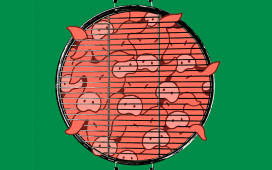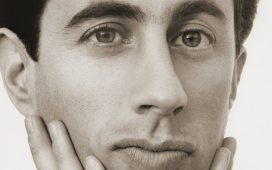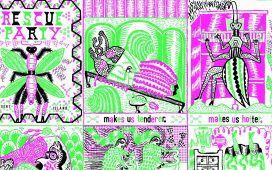A retrospective of the German director Ulrike Ottinger’s films is coming to Metrograph, starting March 14th (she’ll be in town for it), and her body of work is now adorned with a welcome plus-one: the director, whose film career stretches back to 1973, has a new movie that premièred last Saturday, at the Berlin Film Festival, and it’s a great one. Called “Paris Calligrammes,” it’s an essayistic, autobiographical work centered on her formative years in Paris, where she lived from 1962 until 1969.
The film is an extraordinary sort of aesthetico-political nonfiction bildungsroman, in which Ottinger fuses her self-portraiture and her reminiscences with the life of the city and the ideas of the times, as she encountered them. She retraces the personal and intellectual influences that formed her artistry and her personality—starting with her childhood in Konstanz, which was occupied by France in the wake of the Second World War, allowing her to see a steady run of already classic French movies that were screened there for the troops and staff. At the age of twenty, Ottinger headed to Paris, which she considered the capital of the fine arts, in order to become a great artist—and ended up, she says, hitchhiking from the countryside (where her car, which she’d fancifully painted, broke down) to the capital, with a bunch of courtly French gangsters. Yet her rhapsodic tribute to the teeming artistic apprenticeship that Paris soon offered her isn’t solely a vision of beauty: she also observed, and unsparingly recalls, the political and social ugliness with which she was confronted during her time there.
“Paris Calligrammes” is expressly and intimately a postwar film, starting, as she explains in her copious voice-over narration, with its title. When she got to Paris, she soon started frequenting the Librairie Calligrammes, a Left Bank bookstore that was devoted to German literature and founded by the German Jewish exile Fritz Picard. It was a “hangout for Jewish and political émigrés” and for artists and literary people over all—its guest book features, among many others, the signatures of Paul Celan, Tristan Tzara, Julien P. Monod (Jean-Luc Godard’s grandfather), the Surrealist filmmaker Hans Richter (a cue for her to show clips from his inventive and whimsical work), and the writer and artist Walter Mehring. The mention of Mehring’s name gives rise to a grand and mournful sequence, of more than four minutes, launched by Ottinger’s recollection of a reading he gave at the store, which included a furious and sardonic poem, from 1941, about German writers murdered or driven to suicide by the Nazi regime. Ottinger includes Mehring’s impassioned recitation of it on the soundtrack, along with archival images of the writers and of the place—Marseille—where he wrote it.
Ottinger’s method in “Paris Calligrammes” is classical, but her sensibility transforms the film into a work of vital and energetic modernism. She narrates her experiences and delivers her trenchant observations in a spontaneous, seemingly casually associative voice-over that accompanies a prodigious, absorbing, and wide-ranging collage of archival images and film clips, whether from features, documentaries, news sources, or personal collections. These are framed by her cinematic revisitation of current-day Paris, which she realizes with the same blend of confectionary wonder and frank observation (she does her own camera work) that characterizes her dramatic features.
For Ottinger, the Calligrammes bookstore (whose window display she re-creates at the space’s current incarnation, as an art gallery) proved to be both a social anchor for her and a place where she made crucial contacts that sparked her artistic apprenticeship. Even as she details her early days as an artist and her first glimmers of recognition, her reminiscences are insistently but subtly cinema-centric. She pays homage to the art scene in Saint-Germain-des-Prés, moving from the chill of tiny apartments to working life in cafés alongside Simone Signoret, Jean-Paul Sartre, Simone de Beauvoir, and the filmmaker Jean Rouch, who talked and plotted with Marceline Loridan-Ivens on their audacious fusions of documentary and nonfiction (they’re seen working together in a wondrously atmospheric clip).
As meandering as it is, Ottinger’s narration is a profound act of intellectual montage, following pathways of memory with ardent curiosity as they wind deeply through history and connect her personal experience to the artistic and political currents of the time. In the process, she faces and overcomes a serious artistic challenge: her film’s inevitable dependence on archives. The ready access to archival footage and its inclusion by the yard as an evocation of history is one of the curses of modern documentary filmmaking, because archival footage is inevitably a mere approximation, or a facile simulacrum, of a filmmaker’s memories and experiences. Ottinger avoids the curse by way of her own artistic alchemy. The news footage of the events of May, 1968, isn’t exactly what Ottinger saw; neither is footage of her artist friends and mentors Johnny Friedlaender and Ossip Zadkine at work in their studios, nor the scenes showing the activities of food wholesalers—and of gleaners—at the now vanished central marketplace Les Halles. But her precise yet wide-ranging recollections, together with her clear-eyed and high-styled new images of Paris today, transform the archival into the personal, the third person of historical documents into the first person of reëxperiencing her past by way of them.
The fine and strong thread of her memories leads to Montparnasse, where she painted in a tiny studio; it was too small for her canvases, so she painted small canvases and assembled her art works on the ground of a courtyard, observing them together from an overhead height that she reached by way of a rickety freight elevator. The film traces her artistic metamorphoses toward “narrative figuration,” three-dimensional art works, and then “happenings,” where visitors assembled paintings that she’d cut into puzzle pieces, and where she played records in art galleries and displayed the books that she was reading at the time that she made her art objects. From there, she reminisces about café life (illustrated by a clip from Éric Rohmer’s first feature, “The Sign of Leo”) and recalls the political commitment of her Montparnasse friends to the cause of Algerian independence. She recalls their viewing together of Jacques Panijel’s horrifying documentary “October in Paris,” about the violent suppression of a demonstration by Algerian immigrants in October, 1961, and Ottinger hauntingly compares the sites of the massacre, as filmed by Panijel, to their present-day incarnations. She also recollects the involvement of the former Vichy official Maurice Papon (who’d overseen the deportation of Jews to concentration camps) in the massacre, as well as the unassuaged fury of the French right wing and the violent response to Jean Genet’s play “The Screens.”
Ottinger’s personal history lessons also trace the currents of the times through her awakening cinematic ambitions. She recalls the lectures of Claude Lévi-Strauss, which she associates with her own directorial perspective, and—by way of her visits to the anthropological Musée de l’Homme, at the Palais de Chaillot, where Rouch worked—she enfolds her frequent visits to the Cinémathèque Française, which moved to the same complex in 1963, and her association with its guiding spirits, Henri Langlois and Mary Meerson. She displays clips from her own films and reveals their origins in her artistic activities and affinities from her Paris days. When it comes to the demonstrations of May, 1968, which she both participated in and observed from her small apartment in the Latin Quarter (she revisits and films those places and vistas now), her autobiographical visions veer toward hallucinations of history. Her perspective on those events, and on the gap between the revolution that they symbolized and the actual results they delivered, makes for a rueful, paradoxical, tragic envoi: it was afterward that Ottinger left Paris for Germany and left gallery art work for her long and splendid career in the cinema.








